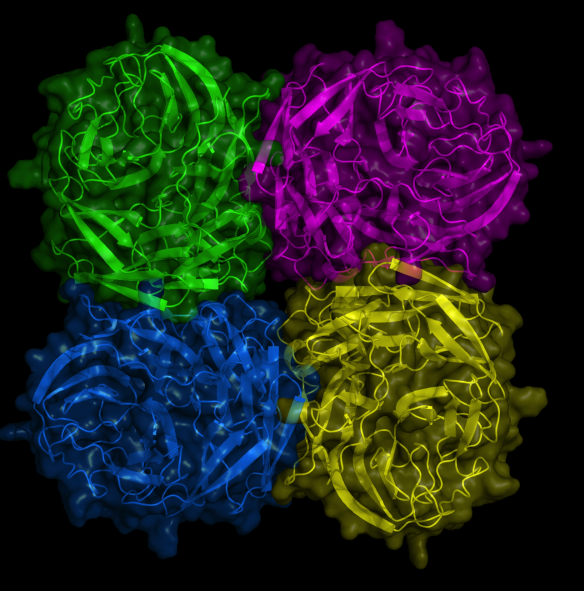Posted on 27/01/2014
Fighting the Flu – The structure of Neuraminidase
What is it?
Swine flu, bird flu, and 'man' flu. They are all caused by the Influenza virus. The flu virus is continually changing. What we do know is that there are two molecules, hemagglutinin and neuraminidase, that sit on the surface of the virus and are critical for infection. Hemagglutinin is responsible for binding to the cells in our body, so that the virus can then inject its viral genome into our cells. Neuraminidase helps to disengage the virus from our cells. The enzyme clips off the chains that anchor the virus to the cell. By blocking the action of neuraminidase, we can stop viral release and spread, and so it has been an important target for drugs targeting the flu.
What does it look like?
Neuraminidase (pdb code 1nn2: http://www.rcsb.org/pdb/explore.do?structureId=1nn2) is composed of four identical sub-units (green, yellow, pink and blue) packed in a square formation. The enzyme is attached to the surface of the flu virus via a stalk (which is not shown in this picture). Neuraminidase binds to polysaccharide chains and clips off the sugars at the end of these chains, releasing the flu virus from our cells.

Image generated by Pymol (http://www.pymol.org/)
Where did the structure come from?
The structure of influenza virus A/Tokyo/3/67 neuraminidase was solved in 1991 by two Australian scientists (Peter Malcolm Colman and Joseph Varghese) (http://www.ncbi.nlm.nih.gov/pubmed/1920428). Since then, many other varieties of flu neuraminidase have been solved, including the swine flu neuraminidase.
Australia’s Role In The War on Flu:
In 1989, scientists at the CSIRO (led by Peter Malcolm Colman and Joseph Varghese) in collaboration with the Victorian College of Pharmacy, Monash University, and Glaxo in the UK, developed the first neuraminidase inhibitor, Zanamivir (marketed as Relenza). Its discovery relied heavily on the availability of the structure of influenza neuraminidase (shown above).
For more information about the discovery of the Relenza drug, see:
M. von Itzstein (2007) The war against influenza: discovery and development of sialidase inhibitors. Nature Reviews Drug Discovery 6, 967-974


